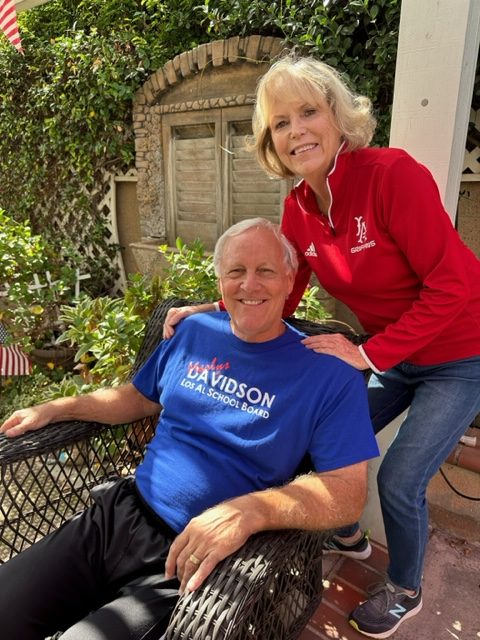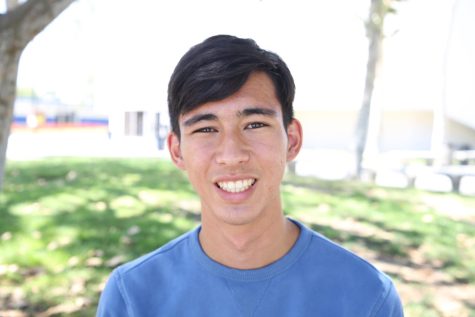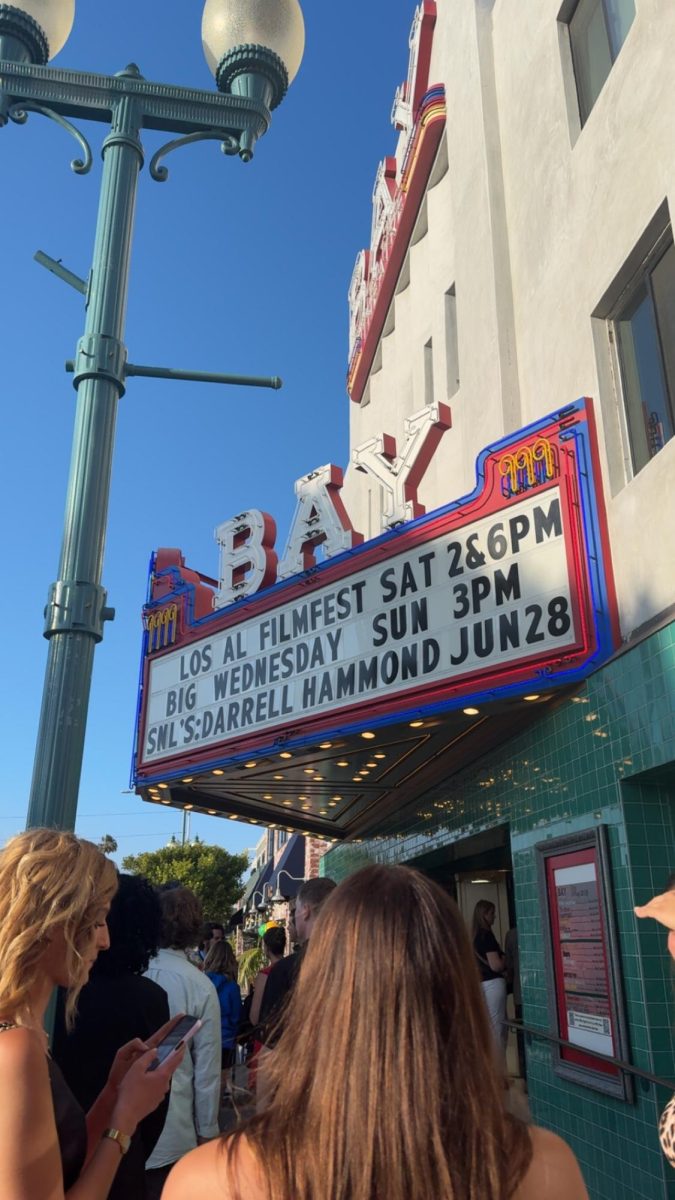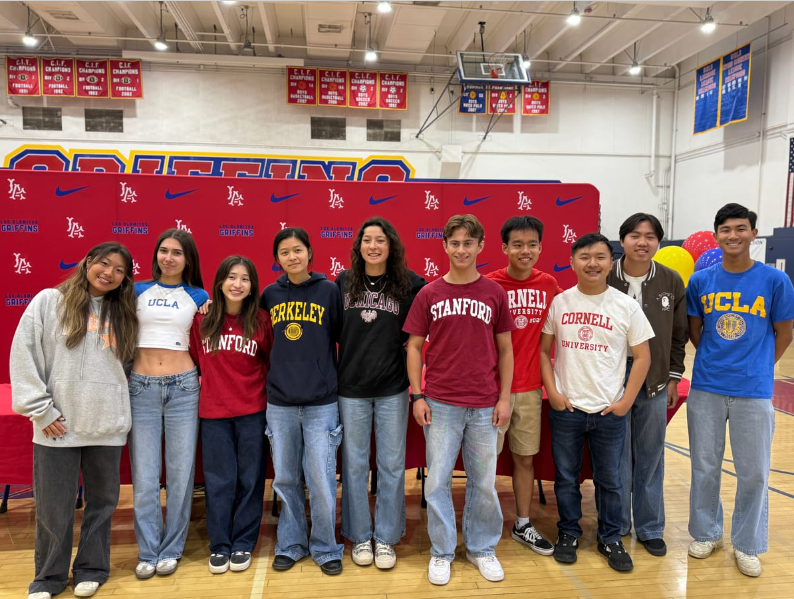The LAUSD vote 2022: Meet Marlys Davidson of Trustee Area 1
Marlys Davidson answers 11 important questions from the Griffin Gazette.
The Marlys Davidson for School Board Campaign
Marlys Davidson (right) with her husband (left).
November 3, 2022
LOS ALAMITOS, CA — The Griffin Gazette is conducting interviews for candidates making their last-minute pitches to voters. Marlys Davidson of Trustee Area 1 is finishing out her first term on the Los Alamitos Board of Trustees and is vying for a second term in office. Unfortunately, the Griffin Gazette could not reach Davidson’s opponent, Colin Edwards.
The Griffin Gazette requested written interviews from all candidates from both trustee areas. Questions for each candidate are the same to ensure that there is a level playing field. The candidates themselves provided each response.
Marlys Davidson sent photos from her campaign to the Griffin Gazette, shown below.
Q1: What were your motives for running for the school board?
I am running for re-election because I believe in the great work that is underway in this district. Although much has been accomplished, there is still much to do. If you re-elect me to the Board, I will move forward with a focus that includes work to:
- Enhance STEM education on every campus.
- Create more CTE (Career Tech Education) partnerships with the community
- Support and expand K-12 arts programs across the district
- Continue to build equity, diversity, and inclusion across every campus.
- Evaluate and enhance support and benefits for our employees
- Continued support and enhancement for the mental health and social-emotional well-being of every student and staff member
- Further develop the important work we are doing with community leaders for school safety
Q2: Are there any central themes to your campaign message?
As a current member of the Los Alamitos Unified District Board of Education, I will continue to be a passionate advocate for students and schools, a strong voice for our community, and an informed decision-maker that puts our students first.
Q3: How do you differ from your opponent? And, why do these differences make you the better option for Los Al?
As a current Board member, I am committed to taking every lesson I have learned, every insight I have gained, and every message this community has given me to find the best solutions for our Los Al School District. My opponent may believe he will do a good job on the Board, but he only recently returned to this community. His last experience with our schools was years ago when he graduated from the high school. He does not know our schools or what we need. Experience and engagement in our community matter, especially right now.
Q4: What experiences do you have that make you qualified for the school board?
In these challenging times, experience and engagement matter. My heart has been in this community nearly my entire life. My children graduated from Los [Alamitos High School]. I have taught in the district for 25 years (three at Rossmoor and 22 at McAuliffe). Every student in my classroom was a voice that mattered deeply to me, and I always listened. As a founding advisor for Peace Company, the middle school version of Griffins With a Mission, I worked with students early on to create appreciation for diversity and inclusion. My years as a leader in staff and curriculum development enabled me to build strong bonds with administration, teachers, and staff across the district as we worked together to build powerful classroom experiences.
Q5: Many are tired of the constant protests and long, drawn out meetings at the Los Alamitos district office. How do you plan to unify a polarized and divided bloc of parents?
As Board President during the height of the unrest, I, too, grew very tired of the angry polarization. [Los Al] students and even some from our middle and elementary schools bravely faced angry crowds meeting after meeting to share their stories and make their requests for change. They were all heroic. Their voices were the most powerful. They were the catalysts for change. Honestly, as Board President, I was not always successful at calming the room and made my own mistakes along the way. What I do know is that no one should be afraid to speak. It is our job to address polarizing perspectives by listening, doing the research, seeking solutions, and then sharing and discussing those solutions in presentations and workshops with the community.
Q6: Sometimes students and parents want different things. Take the Ethic Studies course, it was a student-requested course, but many parents objected to its creating. If such a disagreement were to happen again, how would you appeal to both students and parents?
A carefully created and implemented process to engage and share with all constituents is the path to reaching both sides. The ultimate path to the Ethnic Studies class started months earlier when the demand for a Human Relations Task Force was answered. The outcome of an Ethnic Studies elective and Social Justice Standards can be traced back to the response of the Board and Administration to this task force along with all the voices of students, teachers, parents, and community members requesting the implementation of these to the curriculum. There was very vocal dissent. Our administrators and teachers worked hard to find the right curriculum and standards taking into consideration all perspectives. There were multiple presentations, workshops, and opportunities to preview materials. The process was meant to include and hear all voices along the way.
Q7: Overcrowding in classrooms is a major problem, especially at the high school. How do you plan to reduce classroom sizes?
I wish I had an easy answer to this one. During the 2008 Recession, I had 40 plus students in my eighth grade classroom. I can promise you that I understand your concerns. We as a Board are working with the Administration to look at how to address class size, but I must be honest, there are no easy solutions. Please encourage students to address us on the issue. You have powerful voices.
Q8: The high school has focused heavily on STEAM. However, some students do not want to go into a field pertaining to STEAM and want to purse blue collar jobs instead. Show high school start vocational training programs? Do you think that vocational training programs would be useful for students that do not want to pursue blue collar jobs too? Is there too much of an emphasis on getting students to college when there are a myriad of other career pathways?
We have increased our CTE Pathways and are seeking partnerships that would enable mentoring and internships in our communities in a variety of occupations. The ability to see beyond the classroom and experience real life work situations can inspire students to realize there are many fields that can be both engaging and provide a good living wage which do not necessarily require a four-year degree. Perhaps what is needed is a way to provide a stronger voice for students to engage in addressing these and other issues. I attended a presentation from a high school in San Luis Obispo. Working with the superintendent and principals, the students created a senate that gave them the opportunity to address issues relevant to them. Would our students be interested?
Q9: Many students feel uninterested in school. Sometimes, this is due to students feeling a lack of purpose in the classroom, which can influence graduation rates, grades, and mental health. In what ways, can you, as a school board member, facilitate more purposeful education?
Engagement is a fundamental requirement for every student to learn. As a teacher, I did my best to create an environment that connected with all of my students. Students should always be clear about the relevance of a lesson. Our committed educators participate in professional development trainings that cover a wide variety of areas from equity, diversity, and inclusion to math training at Stanford University. We have a highly dedicated TK-12 staff that are committed to their craft.
In addition, mental health plays a huge role in being engaged and finding purpose. The shutdown took its toll on all of us, but isolation, anxiety, and depression are not new. In 2018, when I first ran for the Board, my former students asked me to meet with them at lunch at the high school. These were students who wanted me to have an honest picture of the mental health issues they and other students faced. Their conversation with me caused me to make mental health top of my list for what I planned to focus on when I got on the Board. Before the pandemic, our Board and Administration had already made mental health and safety a top priority. We have doubled the number of mental health counselors, opened WellSpace Centers for students at the middle schools with one about to open at Los Al. We are actively engaged in this work and welcome hearing from our students as we move forward.
Q10: There are some safety concerns among different groups of people. At the high school, some students fear the rise in drug use, especially with some students vaping in bathroom stalls. Others worry about gun violence due to the likes of Columbine, Sandy Hook, Parkland, and Uvalde. Minority and LGBTQ+ groups sometimes worry about their safety. What proposals do you have to make students feel safe and ready to learn?
We are working hard to address all facets of safety on our campuses. Currently, I am one of two Board members serving on a committee addressing school safety and the threat of a violent intruder on our campuses. This group includes our Superintendent, Director of Safety, Los Alamitos Chief of Police Mike Claburn, and others. All of us are dedicated to addressing every facet of campus safety and providing the training necessary to every staff member. Students need to feel safe from violence, drugs, bigotry, and any other negative forces on campus. We are working to address safety through staff training to support equity, diversity, and inclusion, student and parent education nights, and by addressing situations with restorative practices. I know that it must feel like we are rolling a boulder uphill, but we want to find solutions, and your voices can help us. As I stated before, my students broadened my understanding, perspectives, and focus when they asked me to come to school and listen. Please encourage students to feel free to reach out to me.
Q11: What have you been doing in the closing stretches of your campaign? Where can voters reach you?
It has been a challenging campaign, because there has been no way to meet my opponent and debate the issues. However, I have a wonderful team who have joined me as we continue to knock on doors and meet with small groups across the community. I have listened and taken notes about what is valued as well as what concerns our families and community. Just as I took what I learned from the students who asked to speak with me in 2018, I will take what I have learned in this campaign and bring it to our Board and Administration. I want to take this opportunity to thank the [Los Al] students who came out and canvassed with us. You were our bright lights on the campaign trail!
We are a community that does its best work when we join our hearts and minds to address issues, find innovative solutions, create extraordinary programs, and work to make sure every child has a safe and engaging environment in which to thrive. You, our students, should always have a powerful voice. You have in the past and we welcome it now.
Where to contact Marlys Davidson
For more information about Marlys Davidson, contact her via email at [email protected] or visit her website, marlys4losal.com.







